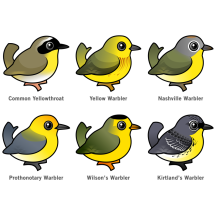Also known as: Blackcap, Black-capped Warbler, Pileolated Warbler, Wilson's Flycatcher
The Wilson's Warbler is a small, lively bird distinguished by its vibrant yellow plumage and a distinctive black cap on the males. Females are slightly less colorful and usually lack the bold black cap. This warbler is quite petite, with a round, plump appearance that adds to its charm. The Wilson's Warbler is named for the ornithologist who discovered the species for science in 1811: Alexander Wilson.
Wilson's Warblers are known for their energetic foraging behavior. They are often seen hopping among shrubbery and low branches in dense thickets, darting about in search of insects and spiders. Their presence is also marked by a cheerful, chattering song that contributes to the lively atmosphere of their habitats.
These warblers breed across northern North America, from Alaska to northern U.S. states, preferring boggy areas, thickets, and mixed forests. They build their nests close to or on the ground, tucked away under dense cover.
In the winter, Wilson's Warblers migrate to Mexico and Central America, where they continue to inhabit similar dense habitats. Their populations are generally stable, but like many migratory birds, they are vulnerable to habitat loss both in their breeding and wintering grounds.
ウイルソンアメリカムシクイ (wiruson'amerikamushikui)





































